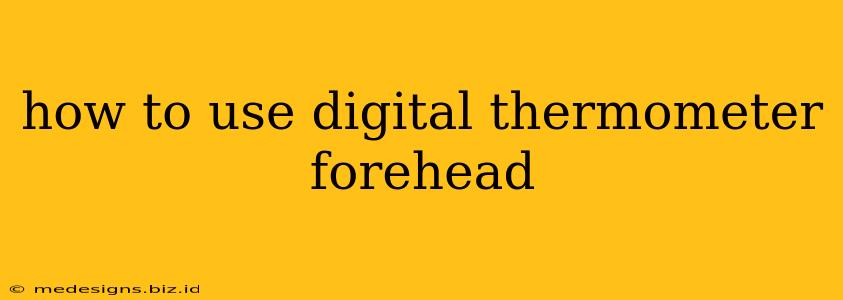Getting an accurate temperature reading quickly and easily is crucial, especially when dealing with illness. Digital forehead thermometers offer a convenient and often less invasive way to check your temperature compared to traditional methods. But knowing how to use one correctly is key to getting reliable results. This guide will walk you through the process, ensuring you get accurate readings every time.
Understanding Your Digital Forehead Thermometer
Before we dive into the how-to, it's important to understand your specific thermometer model. Most digital forehead thermometers operate similarly, but there might be slight variations in features and instructions. Always refer to your thermometer's user manual for specific details and any cautions.
This guide offers general instructions applicable to many models, but individual instructions might differ slightly. Pay close attention to the indicator lights and any beeps your thermometer makes. These are crucial cues for understanding when the reading is complete and if there are any errors.
Preparing for an Accurate Reading
Several factors can influence the accuracy of your reading. Taking steps to prepare beforehand will greatly improve your results:
1. Clean the Thermometer Probe
Hygiene is paramount. Before each use, gently wipe the thermometer's probe with a soft, damp cloth and mild soap. Allow it to air dry completely before using it. This prevents cross-contamination and ensures accurate readings.
2. Allow the Person to Rest
For accurate results, ensure the person whose temperature you're taking has been resting for at least 15-30 minutes. Recent physical activity, such as exercise, or exposure to extreme temperatures can skew the reading.
3. Remove Headwear
Hats, scarves, and other head coverings can interfere with the reading. Remove any head coverings before taking the temperature.
Taking the Temperature: A Step-by-Step Process
Now, let's go through the process of taking a temperature using a digital forehead thermometer:
1. Power On the Thermometer
Press the power button to turn the device on. Wait for it to display a ready signal, often indicated by a stable display or a specific symbol.
2. Position the Thermometer
Hold the thermometer gently against the center of the forehead, just above the eyebrows. Ensure the probe makes good contact with the skin. Avoid pressing too hard, as this could affect accuracy. Many thermometers require you to hold it a certain distance, so again, refer to your manual.
3. Wait for the Reading
Most thermometers beep when the reading is complete. Keep the thermometer in place until you hear the beep. Some models will have a visual indicator of the measurement, and some will have a display with temperature reading.
4. Read and Record the Temperature
Once the beep sounds, read the temperature displayed on the screen. Record this reading, including the time and date, for future reference.
5. Power Off the Thermometer
Turn off the thermometer after you've recorded the reading.
Interpreting the Reading and When to Seek Medical Advice
Once you have the temperature reading, interpret it according to the manufacturer's guidelines. Generally, a temperature above 100.4°F (38°C) in adults is considered a fever. However, always consult your doctor or other healthcare professional if you have concerns about a fever or other symptoms.
Troubleshooting Common Issues
- Inconsistent readings: Make sure you're following the instructions carefully and that the probe is clean and dry. Consider repeating the measurement several times to confirm the reading.
- Error messages: Consult your thermometer's manual for information on troubleshooting error codes or messages.
Remember: Digital forehead thermometers offer convenience but aren't foolproof. If you have any doubts about the accuracy of a reading, or if you're concerned about someone's health, always seek medical advice. This information is for guidance only and does not replace professional medical advice.
